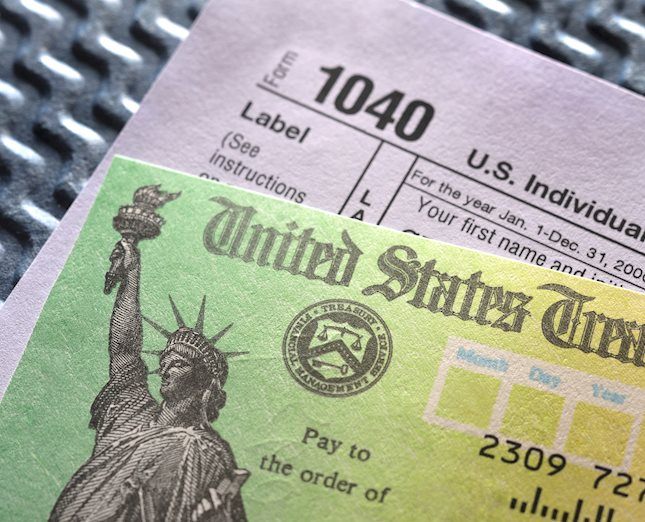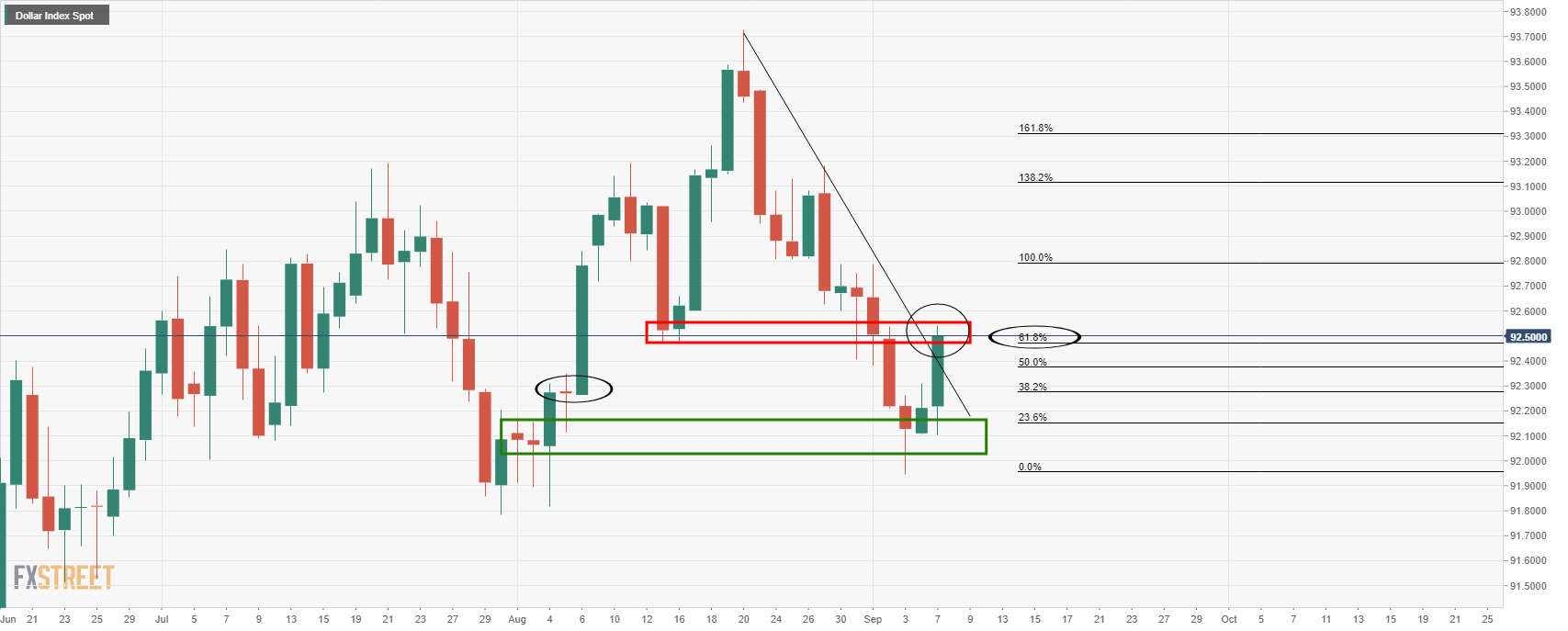- US dollar rallies despite the alarming rate of coronavirus Delta spreading in the US.
- US president Biden to address the nation on Thursday with plans to curb the epidemic.
While the US dollar is strong at the start of the week, (DXY is up today for the first time after six straight down days and has recouped its post-NFP losses to trade near 92.50), it walks a tight rope above the abyss.
It all boils down to the Federal Reserve's caution over the spread of the highly contagious Delta coronavirus variant and its effect on consumer confidence and the central bank's goal of reaching maximum employment.
On Friday, the US printed a terrible miss of expectations in the Nonfarm Payrolls jobs market data. This followed the worst Consumer Confidence data from August in over six months at what was through to be the peak of new cases and deaths.
However, cases have continued to rise and there are no signs of an apex in the nation's epidemic.
The population has just enjoyed a national holiday and it is feared that this will cause a spike in new cases.
Nationwide, the number of covid-19 patients in hospitals has more than doubled since Labor Day last year, from 38,192 on Sept. 7, 2020, to 99,270 by Sept. 6, 2021,'' per data reviewed by The Washington Post and published by the news agency today.
''It is an illustration of how the delta variant has hampered progress in curbing the pandemic even as vaccines became widely available,'' The Washington Post wrote.
The US has recorded roughly 650,000 COVID-19 deaths and last week exceeded 40 million cases.
Reuters data shows that more than 20,800 people have died in the United States from COVID-19 in the past two weeks, up about 67% from the prior two-week period.
''Hospitalizations have grown, with seven US states - Alaska, Georgia, Hawaii, Idaho, Kentucky, Tennessee and Washington - reporting records this month,'' the news agency reported.
Vaccinations are key
As the Delta variant surge continues throughout much of the U.S., there has been a renewed effort to jump-start the country’s stalled vaccination program.
Here’s the latest data, updated on Sept. 7 (Source: medical Economics):
- Positive tests: 40,018,318.
- Patient deaths: 648,998.
- Total vaccine doses distributed: 450,175,825.
- Patients who've received the first dose: 206,908,710.
- Patients who’ve received the second dose: 175,968,266.
- % of the population fully vaccinated: 53%.
This data represents three-quarters of adults in the United States that have received at least one dose of the coronavirus vaccine as of Tuesday, according to tracking by The Washington Post.
''As the country headed into Labor Day, 74.9 percent of people 18 and older had received at least their first shot, The Post’s data shows. On Tuesday, the White House said an additional 1.5 million doses were administered over the holiday weekend, pushing adult vaccinations to 75 percent.,'' the Washington Post wrote on Tuesday.
Another reason to take stronger measures to control the spread of the virus is to reduce the risk that another, more dangerous, variant will arise.
“The biggest concern is that when the coronavirus is allowed to spread from person to person, there is a risk that the virus will mutate into a form that is no longer susceptible to the immune protection generated by the vaccines,” said Dr. Lewis S. Nelson, professor and chair of emergency medicine at Rutgers New Jersey Medical School.
Meanwhile, President Joe Biden on Thursday will present a six-pronged strategy intended to fight the spread of the highly contagious coronavirus Delta variant and increase US COVID-19 vaccinations, the White House said on Tuesday.
White House spokeswoman Jen Psaki told reporters that he will lay out the six-pronged strategy "working across the public and private sectors to help continue to get the pandemic under control."
"We need to continue to take more steps to make sure school districts are prepared and make sure communities across the country are prepared," Psaki added.
On Wednesday, Biden is scheduled to meet with White House COVID-19 advisers.
DXY technical & fundamental analysis
Meanwhile, the US dollar is enjoying a positive correction at the start of this week and has moved back into positive territory, despite the risks pertaining to Delta.
The price has broken into critical resistance and has even priced the dynamic trendline resistance.
Should the price break higher, closing beyond a 61.8% Fibonacci on a daily closing basis, then the bulls will be well and truly in the driver's seat.
However, the caveat is how well the vaccination programme goes in the US between now and the next series of months of jobs data this final quarter.
Should there be little improvement in Consumer Confidence nor headway towards the Fed's maximum employment goals, then there will be little chance of a Fed taper this side of 2022.
In such a scenario, the US dollar could lose out to other nations where headway has been made towards tapering of their QE programmes leaving the US dollar vulnerable to the downside.
This week's European Central Bank meeting will be critical in this regard. A hawkish surprise could boost the euro and subsequently weigh on the DXY which is heavily weighed against the single currency.
In doing so, the DXY will be back looking into the abyss ahead of the next Fed meeting later this month.
Information on these pages contains forward-looking statements that involve risks and uncertainties. Markets and instruments profiled on this page are for informational purposes only and should not in any way come across as a recommendation to buy or sell in these assets. You should do your own thorough research before making any investment decisions. FXStreet does not in any way guarantee that this information is free from mistakes, errors, or material misstatements. It also does not guarantee that this information is of a timely nature. Investing in Open Markets involves a great deal of risk, including the loss of all or a portion of your investment, as well as emotional distress. All risks, losses and costs associated with investing, including total loss of principal, are your responsibility. The views and opinions expressed in this article are those of the authors and do not necessarily reflect the official policy or position of FXStreet nor its advertisers. The author will not be held responsible for information that is found at the end of links posted on this page.
If not otherwise explicitly mentioned in the body of the article, at the time of writing, the author has no position in any stock mentioned in this article and no business relationship with any company mentioned. The author has not received compensation for writing this article, other than from FXStreet.
FXStreet and the author do not provide personalized recommendations. The author makes no representations as to the accuracy, completeness, or suitability of this information. FXStreet and the author will not be liable for any errors, omissions or any losses, injuries or damages arising from this information and its display or use. Errors and omissions excepted.
The author and FXStreet are not registered investment advisors and nothing in this article is intended to be investment advice.
Recommended content
Editors’ Picks

EUR/USD falls to fresh daily lows below 1.0400 after upbeat US data
EUR/USD came under selling pressure early in the American session following the release of United States macroeconomic figures. The December ISM Services PMI unexpectedly surged to 54.1, while November JOLTS Job Openings rose to 8.1 million, also bearing expectations.

GBP/USD extends retracement, struggles to retain 1.2500
GBP/USD lost further traction and battles to retain the 1.2500 mark after hitting an intraday high of 1.2575. Stock markets turned south after the release of upbeat American data, providing fresh legs to the US Dollar rally.

Gold holds on to modest gains amid a souring mood
Spot Gold lost its bullish traction and retreated toward the $2,650 area following the release of encouraging US macroeconomic figures. Jumping US Treasury yields further support the US Dollar in the near term.

Bitcoin Price Forecast: BTC holds above $100K following Fed’s Michael Barr resign
Bitcoin edges slightly down to around $101,300 on Tuesday after rallying almost 4% the previous day. The announcement of Michael S. Barr’s resignation as Federal Reserve Vice Chair for Supervision on Monday has pushed BTC above the $100K mark.

Five fundamentals for the week: Nonfarm Payrolls to keep traders on edge in first full week of 2025 Premium
Did the US economy enjoy a strong finish to 2024? That is the question in the first full week of trading in 2025. The all-important NFP stand out, but a look at the Federal Reserve and the Chinese economy is also of interest.

Best Forex Brokers with Low Spreads
VERIFIED Low spreads are crucial for reducing trading costs. Explore top Forex brokers offering competitive spreads and high leverage. Compare options for EUR/USD, GBP/USD, USD/JPY, and Gold.
